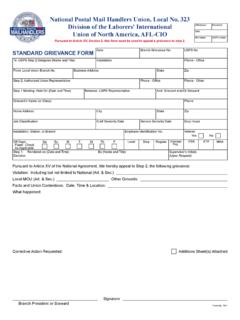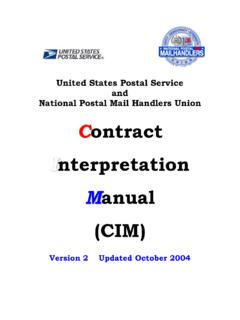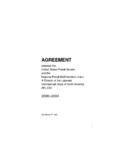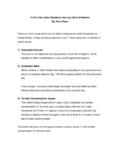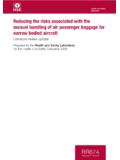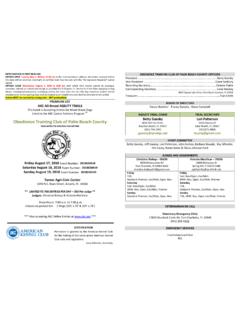Transcription of Musculoskeletal ill-health risks for airport baggage …
1 health and Safety Executive Musculoskeletal ill- health risks for airport baggage handlers Report on a stakeholder project at East Midlands airport Prepared by the health and Safety Laboratory for the health and Safety Executive 2009 RR675 Research Report health and Safety Executive Musculoskeletal ill- health risks for airport baggage handlers Report on a stakeholder project at East Midlands airport Laraine Oxley David Riley Sarah Tapley health and Safety Laboratory Harpur Hill Buxton Derbyshire SK17 9JN In Great Britain the majority of baggage handling is contracted out from the airline to ground handlers and is often viewed as a stand alone part of the aircraft turnround process. Little consideration has been given to the design and working of the interface between the aircraft (airline carrier), airport (operator), handling equipment (supplier/ manufacturer) and those persons undertaking the baggage handling work (ground handlers ). Unless these factors are dealt with at an early stage, there is often little or no opportunity for the ground handler to address and reduce the risks .
2 Fully effective risk reduction during the baggage handling activity will only be achieved if all the parties involved actively work together. This report describes the work undertaken to gather further information on the Musculoskeletal ill- health risks associated with baggage handling operations and to appraise the efficacy of new Extending Belt Loader (EBL) technology. The GB aviation sector health and safety steering group (Revitalising health and Safety in Air Transport -RHSAT), which includes the HSE, identified the requirement for a working partnership. Staff from the HSE, HSL, East Midlands airport (EMA), Menzies Aviation, Servisair, EasyJet, BMI Baby and the Civil Aviation Authority (CAA) formed a collaborative working group to take this work forward. The evidence presented in this report, and other studies including previous work by the HSE (Tapley & Riley, 2005 and Riley, 2008) provide a strong case for this task to be re-designed or mechanised to reduce the risk of injury.
3 This report and the work it describes were funded by the health and Safety Executive (HSE). Its contents, including any opinions and/or conclusions expressed, are those of the authors alone and do not necessarily reflect HSE policy. HSE Books Crown copyright 2009 First published 2009 All rights reserved. No part of this publication may be reproduced, stored in a retrieval system, or transmitted in any form or by any means (electronic, mechanical, photocopying, recording or otherwise) without the prior written permission of the copyright owner. Applications for reproduction should be made in writing to: Licensing Division, Her Majesty s Stationery Office, St Clements House, 2-16 Colegate, Norwich NR3 1BQ or by e-mail to ii ACKNOWLEDGEMENTS The authors acknowledge the assistance of the East Midlands airport (EMA) project team members, and those others who have contributed. Without their valuable input this work would not have been possible. The project team: Craig Charlesworth Menzies Aviation Greg Foster - Servisair, EMA Anne Kilker East Midlands airport Ian Meredith - Servisair health and Safety Manager, EMA Keith Merrie - BMI health and Safety Risk Manager Adey Neal East Midlands airport Laraine Oxley health and Safety Laboratory Simon Prower EasyJet Ground Operations Policy and Standards Manager Terry Ramage Menzies Aviation Tim Rane FMC airport Systems David Riley health and Safety Laboratory Sarah Tapley health and Safety Executive Colin Terry Unite T&G Section Gordon Whitelaw - Menzies Aviation, EMA iii iv CONTENTS 1 1 2 RAMP HANDLING OPERATIONS AT THREE GB AIRPORTS.
4 3 Background: Manual handling the risk factors .. 3 The job of the baggage handler .. 3 Description of baggage handling working methods .. 4 Direct to hold (fully manual) handling .. 5 Mechanically assisted handling .. 6 Summary .. 9 3 RAMP HANDLING OPERATIONS Musculoskeletal risks .. 11 Approach .. 11 15 Summary .. 32 4 TRIAL OF AN EBL AT EAST MIDLANDS airport .. 35 Approach .. 35 35 Hierarchy of risk 42 Qualitative data from questionnaire / interviews .. 45 Summary .. 46 5 Musculoskeletal DISORDER SYMPTOMS .. 49 Approach .. 49 Results Personal demographics .. 50 Results - Musculoskeletal disorder 52 Summary .. 59 6 61 baggage handling methods risk comparison .. 61 Musculoskeletal symptom reports .. 62 Manual movement of GSE and aircraft steps .. 62 Other observations .. 63 7 65 8 67 9 69 10 GLOSSARY .. 91 v vi EXECUTIVE SUMMARY In Great Britain the majority of baggage handling is contracted out from the airline to ground handlers and is often viewed as a stand alone part of the aircraft turnround process.
5 Little consideration has been given to the design of the interface between the aircraft (airline carrier), airport (operator), handling equipment (supplier/manufacturer) and those persons undertaking the baggage handling work (ground handlers ). Unless these factors are dealt with at an early stage, there is often little or no opportunity for the ground handler to address and reduce the risks . Fully effective risk reduction during the baggage handling activity will only be achieved if all the parties involved actively work together. This report describes the work undertaken to gather further information on the Musculoskeletal ill- health risks associated with baggage handling operations and to appraise the efficacy of new Extending Belt Loader (EBL) technology. The GB aviation sector health and safety steering group (Revitalising health and Safety in Air Transport - RHSAT), which includes the HSE, identified the requirement for a working partnership.
6 Staff from the HSE, HSL, East Midlands airport (EMA), Menzies Aviation, Servisair, EasyJet, BMI Baby and the Civil Aviation Authority (CAA) formed a collaborative working group to take this work forward. The evidence presented in this report, and other studies including previous work by the HSE (Tapley & Riley, 2005 and Riley, 2008) provide a strong case for this task to be re-designed to reduce the risk of injury. OBJECTIVES 1. Agree a definition for the narrow-bodied aircraft of concern; 2. Collect and record weight/frequency data of the baggage handled; 3. Review current handling methods and assess associated levels of risk of injury; 4. Evaluate new extending belt technologies. MAIN FINDINGS baggage handling methods risk comparison The assessment of the current baggage handling methods identifies a number of manual handling related factors, which expose a significant proportion of the working population to the risk of injury. This includes the vertical height and distance of the lift, the horizontal distance of the hands from the lower back, trunk twisting and sideways bending, postural constraints and the grip on the load (HSE, 2004).
7 The potentially high load weights combined with the frequency of handling also contribute to the risk of injury. A comparison of the risk ratings of five different baggage handling methods indicates the following hierarchy of risk, starting with the lowest: 1. EBL type technology There is a risk reduction for the external worker in terms of postural improvement for an EBL with a height adjusting and extending belt, however, for other EBLs without this capability the risk is the same as that for a conventional belt loader. There is a considerable risk reduction for the internal worker through the automation of the transfer of the bags down the hold, the reduction in lifting required, and the posture when lifting. 2. Beltloader The vertical lift region when using a belt loader generally remains above knee and below shoulder level. When poorly set up the there may be an increased vii tendency for trunk twisting and/or sideways bending.
8 Compared to the EBL, there is an additional need to manually move items along the hold. This function needs to be performed by an extra worker positioned within the hold doorway for on-loads, and by the un-stacking worker during off-loads. For the internal stacking and un-stacking workers, the risks are the same as for the Mallaghan LBT90 and direct to hold methods. 3. Mallaghan LBT90 The change in risk associated with the Mallaghan LBT90 is only for the external workers using it. The vertical lift region is similar to that observed when using a belt loader, and reach distances to grasp and place items are generally improved compared to using a beltloader. There is a risk that the hand distance from the lower back is increased if the belt mechanism fails or jams temporarily. Also, if workers then have to stand on the belt to move the bags there is a risk of slipping. The external handler will generally have the additional risk associated with transferring the bags down the hold to the in-hold stacker.
9 Due to the relative position of the stack and the hold, there is considered to be an increased tendency for trunk twisting, but in our observations the proportion of time spent in these postures was small. The platform surface has the potential to be slippery. For these reasons the risk is ranked slightly higher than for belt loader use. However, there are no baggage carts required, avoiding the possibility that they might be moved manually. 4. Direct to hold from ground level The vertical lift region can be between cart and above head height depending on the sill height of the hold door. There is also the additional risk associated with reaching to the opposite side of the cart compared to the Mallaghan LBT90. The external handler will generally transfer the bags down the hold to the in-hold stacker. 5. Direct to hold using a flatbed truck The vertical lift region occurs between close to floor level and shoulder level.
10 Depending on the headroom, the hold doorway can restrict the external handlers posture. There is also a tendency for both trunk twisting and sideways bending for the external worker at the hold doorway. There is an increased risk of a fall from low height due to working on an open platform that has the potential to be slippery. The need for the external worker to transfer bags down the hold remains. For these reasons the risk is considered to be greater than when loading direct to hold from ground level. It is important to note that other approaches, such as the moving hold floor technology of the Sliding Carpet Loading System (SCLS) when used in combination with advanced belt loaders such as the RTT Longreach (Telair International AB) are considered to offer similar risk control advantages to the EBL technology (Riley, 2008). The EBL technology trialled in this project reduces the risk of injury primarily through the mechanisation of the transfer of bags down the hold and the use of height adjustable belts.










